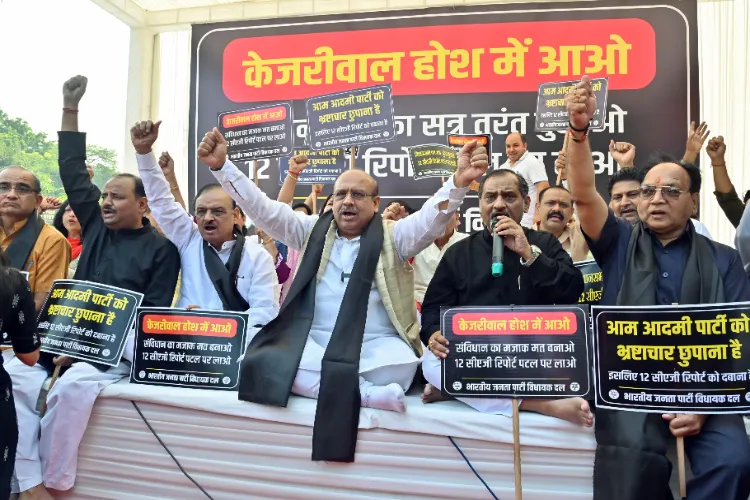
New Delhi
The BJP government in Delhi, led by Chief Minister Rekha Gupta, tabled the CAG report on the Delhi Excise Policy in the Delhi Assembly on Tuesday.
The 'Performance Audit on Regulation and Supply of Liquor in Delhi' spans four years, from 2017-18 to 2020-21, and examines the regulation and supply of Indian Made Foreign Liquor (IMFL) and Foreign Liquor in the city.
This report is one of 14 pending CAG reports concerning the performance of the previous Aam Aadmi Party government.
According to the report tabled today, the audit revealed numerous discrepancies in how the Excise Department monitored and regulated the supply of liquor in the National Capital Territory of Delhi.
The findings showed that the state government suffered cumulative losses exceeding Rs 2,000 crore due to the 2021-2022 excise policy.
The audit raised several concerns regarding the Excise Department's ability to fulfil its responsibilities. The total financial implication of the audit's findings amounts to approximately Rs 2,026.91 crore, as outlined in the report overview.
The audit found that the Excise Department failed to enforce Rule 35 of the Delhi Excise Rules, 2010, which prohibits issuing multiple licenses to related parties across different categories (e.g. Wholesaler, Retailer, HCR, etc.), leading to common directorships among entities holding various licenses.
The audit indicated that the department issued licenses without verifying essential requirements under the Excise Rules and the Terms and Conditions for different types of licenses. It was observed that licenses were granted without ensuring solvency, submission of audited financial statements, details of sales and wholesale prices declared in other states, or verifying criminal records from the competent authority.
The audit also pointed out that the Excise Department allowed the L1 licensee (Manufacturer and Wholesaler) to declare its Ex-Distillery Price (EDP) for liquor priced above a certain threshold. The pricing structure, which included the manufacturer's profit, was found to be prone to manipulation by the L1 licensee, leading to inflated prices and decreased sales, which in turn resulted in a loss of excise revenue.
The audit stressed the need for transparency in EDP declarations, recommending that cost sheets should be obtained to support the declared prices. The department should regulate pricing to optimise excise revenue while considering its impact on sales.
The audit also highlighted issues with the quality control process. Ensuring that liquor supplied in Delhi meets prescribed quality standards is the responsibility of the Excise Department. However, the audit found multiple instances where test reports failed to comply with Bureau of Indian Standards (BIS) specifications, and licences were issued despite significant shortcomings. Test reports related to water quality, harmful ingredients, heavy metals, and other factors were found to be incomplete or outdated.
Weak regulatory functioning was another area of concern. The audit observed that the role of the Excise Intelligence Bureau (EIB) was largely limited to recording seizures and disposing of case property. The department's data was fragmented, hindering any efforts to derive actionable insights. The enforcement process was also found to be ineffective, with issues such as poor execution of raids, lack of standard procedures, and weak evidence collection.
The audit noted deficiencies in the department’s ability to track inventory. The failure to scan liquor during sales led to issues with stock reconciliation, undermining inventory accuracy and regulatory effectiveness. The planned project of Excise Adhesive Labels, intended to improve label security, was also not implemented, thus failing to achieve the desired level of traceability and authenticity.
In addition, the audit found issues with the formation of the new Excise Policy. Several recommendations from the Expert Committee were ignored, and the rationale for key policy changes was not documented. These changes included granting wholesale licences to private entities rather than state-owned ones, and allowing applicants to acquire up to 54 retail vends instead of a maximum of two.
The audit also identified problems in the design and awarding of licences. The new policy's structure, which imposed exclusivity between manufacturers and wholesalers and established retail zones, created a higher risk of monopolies and cartels. The number of wholesale licences granted under the new policy decreased significantly, while retail licences were concentrated in the hands of fewer entities.
The report also found flaws in policy implementation. Some retail licences were surrendered before the policy period ended, leading to supply disruptions. The government did not retender the surrendered licences, resulting in a revenue loss of approximately Rs 890 crore. The department also failed to take timely action to ensure equitable distribution of retail vends in non-conforming wards, further exacerbating the situation.
ALSO READ: Saklain Yousuf’s Kashmiri GPT: A big step towards preserving, promoting Kashmiri
Finally, the audit highlighted issues with revenue loss, including exemptions granted to zonal licence holders, which led to a loss of approximately Rs 941 crore. Incorrect collection of security deposits also resulted in a revenue loss of around Rs 27 crore.
In conclusion, the audit found that the new excise policy, intended to eliminate spurious liquor sales and combat bootlegging, failed to implement critical measures such as liquor testing laboratories and batch testing for quality assurance. These implementation failures contributed to a total loss of approximately Rs 2,002 crore in revenue.
